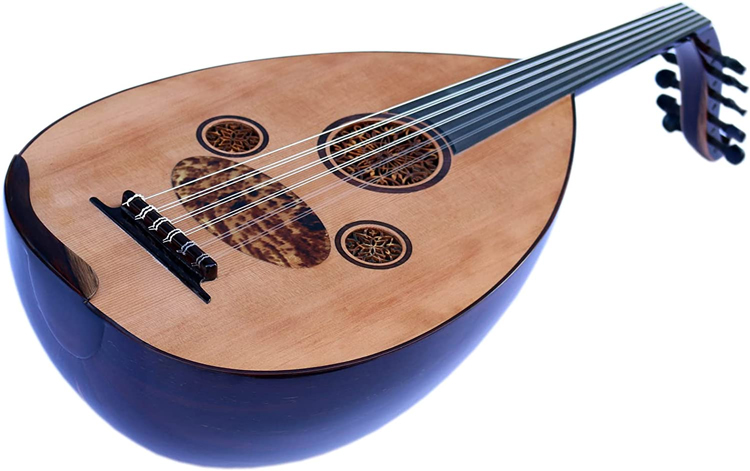The oud (also spelled ud, l’ud and ‘ud) is a stringed instrument that is commonly used in Arabic, Persian, Turkish, Armenian, and Central Asian music. It is a pear-shaped instrument with a long neck and 10–12 strings, which are plucked with a plectrum to produce a rich, resonant sound.
In 2022, Crafting and playing the Oud was Inscribed (17.COM) on the Representative List of the Intangible Cultural Heritage of Humanity under a submission made by Iran and Syria.
The instrument is often used in ensemble settings, accompanying vocalists or other instruments, and is also a popular solo instrument that performs Arabic, Persian, or Turkish classical music, along with Central Asian and Armenian music. Additionally, the oud is used to play traditional songs and dance, in a wide range of events. It is transmitted through apprenticeships and in musical centers, colleges, and universities in urban areas.

Making an oud takes up to twenty-five days, during which the wood is left to dry and harden and is thereupon treated with water and steam for fifteen days to strengthen its durability.
Ouds are constructed in different sizes for different sized-bodies and decorated with wooden carvings and mosaic designs. They regularly have five twin strings, although a sixth string can be added. Crafters are primarily men, although in recent years, young women have developed an interest as well.
With its bass and baritone ranges, the oud can produce melodic and harmonic tones.
Over the centuries, the oud has been developed and refined by musicians in the Middle East, Central Asia, Armenia, and North Africa.
While the oud is an important instrument in Persian, Arabic, Turkish and Armenian music, there may be some regional variations in the way the instrument is made or played. For example, in some parts of the Arab world, the oud may have a larger body and a longer neck, while in other regions, it may be smaller and have a shorter neck.
Additionally, different schools of oud playing may have developed in different regions, leading to variations in technique and playing style.
Currently, the oud has extended beyond the Middle East, Caucasus, North Africa and Central Asia. Renowned oud players are also found in North America, Australia, and Western Europe.
The Late Oud Masters
Leading oud players in the 20th century included Yorgo Bacanos (1900-1977), Farid Al-Atrash (1917–1974), Riad Al Sunbati (1906–1981), George Mgrdichian (1935 – 2006), Mohamed el-Qasabgi (1892 – 1966), Cevdet Kozanoğlu (1896-1986), Munir Bashir (1930–1997), and Hamza El Din (1929 – 2006).
Leading Male Our Players
Some of the finest male oud players currently are Yurdal Tokcan, Naseer Shamma, Ara Dinkjian, Simon Shaheen, Rahim Al Haj, Ramy Adly, Mamdoh Al Gebaly, Mohammed Abou Zekry, Mustafa Said, Ahmed Al Shaiba, Riad Al Sunbati, Abadi Al Johr, Marcel Khalife, Anouar Brahem, Dhafer Youssef, Charbel Rouhana, Omar Bashir, Le Trio Joubran (Samir Joubran, Wissam Joubran and Adnan Joubran), Joseph Tawadros, Adel Salameh, Alan Shavarsh Bardezbanian, Halit Süleyman, Alaa Alkhateb, and Gordon Grdina.
The Finest Female Oud Performers
The most notable female ud players are Shereen Al Tohamy (Sherine Tohamy), Negar Bouban, Kamilya Jubran, Nina Boutchakjian, Clarissa Bitar, Yasamin Shahhosseini, Fatemeh Dehghani, Aliya Cycon, Amal Waqar, Cindy Latty, Salma Kilany, Nawal Al Zoghbi, Huda Asfour, and Layal Abboud.
Oud Innovators and Fusionists
Since the 1970s, oud players have been playing fusions of various musical styles and traditions. For example, German musician Roman Bunka combined jazz and world music; various Arab musicians like the Joubran brothers have incorporated flamenco to their shows; another flamenco fusionist using oud is Spain-based guitarist Amir-John Haddad; and the groundbreaking bands Ekova, Speed Caravan and DuOud mixed Arabic music with various other genres, including electronica. Moreover, Mehdi Haddab and Jean-Pierre Smadja (aka Smadj) have pioneered the use of the electric oud.
(headline image: Nigra Turkish oud made by Mustafa Copcuoglu, Sala Muzik)
Oud Books
The Mukhtar Method – Oud Beginners: Learn Oud by Ahmed Mukhtar
The Mukhtar Method – Oud Upper Advanced by Ahmed Mukhtar
Basics of Oud by Marina Toshich


